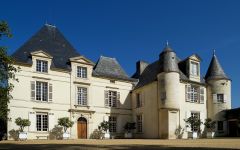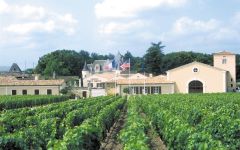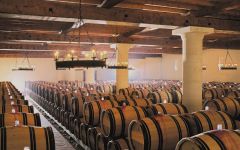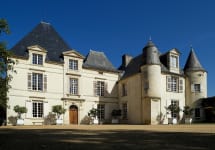Chateau Haut-Brion 2019
-
James
Suckling -
Robert
Parker -
Jeb
Dunnuck - Decanter
-
Wine
Spectator




Product Details
Your Rating
Somm Note
Winemaker Notes
The wine is a superb, deep purple-red color. The first nose is at once intense and subtle. It has a ripe fruitiness, and swirling brings out its aromatic complexity.The first expression is incredibly smooth and delicate, expanding and filling the palate without ever “flexing its muscles”. The tannins are precise but not aggressive, and subtly enchanting. The finish is long and fragrant. Once again, Haut-Brion surprises for its ability to enhance the complementarity of Merlot, Cabernet Franc and Cabernet Sauvignon.
This Haut-Brion 2019 vintage is one of the most successful vintages produced after a hot and dry summer. This fine wine has the structure of a 2005, with the freshness of a 2010. A modern, richer version of the 1990 vintage.
Professional Ratings
-
James Suckling
The is very refined and elegant with a fine-tannined line running through the center of the palate. It’s very intense and precise. Full-bodied with great, tight fruit. This is subtle and complex, then it opens on the palate and shows incredible depth and intensity. Great length, going on and on for minutes.
Barrel Sample: 99-100 -
Robert Parker's Wine Advocate
The 2019 Haut-Brion is a blend of 48.7% Merlot, 43.2% Cabernet Sauvignon and 8.1% Cabernet Franc, harvested from the 10th of September to the 3rd of October. The estimated label alcohol degree is 14.5%. Displaying a deep garnet-purple color, it comes off incredibly shy and reticent to begin, needing considerable coaxing to reveal notes of dark chocolate-covered cherries, blackberry preserves, woodsmoke and sandalwood, before launching into a full-scale fireworks display of iron ore, cumin seed, redcurrant jelly, red roses, oolong tea and Sichuan pepper scents plus a waft of cardamom. The medium to full-bodied palate delivers the most exquisitely ripe, finely grained tannins with a lively backbone of freshness supporting the tightly wound, earth-laced black fruit layers, finishing very long and minerally. This is one of the most finely structured, tightly knit wines of the vintage. Given time, I wouldn't be at all surprised if it goes atomic and eventually takes top place for the vintage.
Barrel Sample: (97-99)+ -
Jeb Dunnuck
The Grand Vin 2019 Château Haut-Brion checks in as a classic blend of 49% Merlot, 43% Cabernet Sauvignon and the rest Cabernet Franc. Its deep purple hue is followed by a stunning bouquet of ripe black cherry and currant-like fruit as well as classic Graves cold fireplace, burning embers, tobacco, and cedar pencil. More regal, firm, and classically structured on the palate, this full-bodied beauty has a deep, concentrated mid-palate, building tannins, background oak, and a great, great finish. It's very much in the focused, elegant, yet still concentrated and powerful style of the vintage. It will need a solid decade of cellaring, but it’s a brilliant wine. Best after 2032. Rating: 98+
-
Decanter
Powerful and confident, there is no mistaking this concentration of ripe damson and black cherry fruits, set against coffee, earth, sage and black chocolate. Tons of tannins on display but extremely fine, to the point that you almost don't notice them, then once the wine has left your mouth you suddenly realise how many there are, and how they are still exerting a pressure. Great persistency, slowing everything down and asking you to stop and think. Clear ageing ability here. Harvest September 10 to October 3.
Barrel Sample: 97
Barrel Sample: 97 -
Wine Spectator
A beauty, with a remarkably refined feel from start to finish, as the caressing but substantial structure lets waves of steeped plum, mulled raspberry and blackberry preserve roll through repeatedly, picking up singed alder and apple wood, dried anise and sweet tobacco accents through the finish, where a curl of woodsmoke lingers. Merlot, Cabernet Sauvignon and Cabernet Franc. Best from 2024 through 2038.
Other Vintages
2024-
James
Suckling - Vinous
-
Robert
Parker
-
James
Suckling - Decanter
- Vinous
-
Jeb
Dunnuck -
Robert
Parker
-
James
Suckling -
Jeb
Dunnuck -
Robert
Parker - Decanter
-
Wine
Enthusiast - Decanter
-
Robert
Parker -
James
Suckling - Vinous
-
Jeb
Dunnuck -
Wine
Spectator
-
Jeb
Dunnuck -
Robert
Parker -
James
Suckling -
Wine
Enthusiast - Decanter
-
Robert
Parker -
James
Suckling -
Jeb
Dunnuck -
Wine
Enthusiast -
Wine
Spectator - Decanter
-
James
Suckling -
Robert
Parker - Decanter
-
Wine
Spectator -
Wine
Enthusiast -
Jeb
Dunnuck
-
Wine
Enthusiast -
Robert
Parker -
James
Suckling - Decanter
-
Jeb
Dunnuck -
Wine
Spectator
-
Robert
Parker -
Jeb
Dunnuck -
James
Suckling -
Wine
Spectator - Decanter
-
Wine
Enthusiast
-
Wine
Enthusiast -
James
Suckling -
Jeb
Dunnuck -
Wine
Spectator -
Robert
Parker - Decanter
-
James
Suckling -
Robert
Parker -
Wine
Enthusiast -
Wilfred
Wong -
Wine
Spectator
-
James
Suckling -
Wine
Spectator -
Wine
Enthusiast -
Robert
Parker
-
Jeb
Dunnuck -
Robert
Parker -
Wine
Spectator -
Wine
Enthusiast -
James
Suckling
-
Robert
Parker -
James
Suckling - Decanter
-
Wine
Spectator -
Wine
Enthusiast
-
Wine
Enthusiast -
Robert
Parker -
James
Suckling -
Wine
Spectator
-
Wine
Enthusiast -
Robert
Parker -
Wine
Spectator
-
Robert
Parker -
Wine
Enthusiast -
Jeb
Dunnuck -
Wine
Spectator -
Wine &
Spirits
-
Wine
Spectator -
Robert
Parker -
James
Suckling -
Jeb
Dunnuck - Decanter
-
Wine
Enthusiast -
Wine &
Spirits
-
Wine
Enthusiast -
Wine &
Spirits -
Wine
Spectator -
Robert
Parker
-
Wine
Spectator -
Wine
Enthusiast -
Robert
Parker
-
Jeb
Dunnuck -
Wine
Spectator
-
Wine
Spectator -
Wine &
Spirits -
Robert
Parker
- Decanter
-
Robert
Parker -
Jeb
Dunnuck -
Wine
Enthusiast -
James
Suckling -
Wine &
Spirits -
Wine
Spectator
-
Robert
Parker -
Wine
Spectator -
James
Suckling
-
Wine
Spectator -
Robert
Parker
-
Wine
Spectator
-
Robert
Parker -
Wine
Spectator
-
Robert
Parker -
Wine
Spectator
-
Wine
Spectator -
Robert
Parker
-
Robert
Parker -
Wine
Spectator
-
Robert
Parker -
Wine
Spectator
-
Robert
Parker -
Wine
Spectator
-
Wine
Spectator -
Robert
Parker
-
Robert
Parker
-
Robert
Parker - Decanter
-
Wine
Spectator
-
Wine
Spectator
-
Robert
Parker -
Wine
Spectator
-
Robert
Parker
-
Robert
Parker
-
Wine
Spectator
-
Robert
Parker -
Jeb
Dunnuck




Chateau Haut-Brion is the oldest and by far the smallest of the "Premiers Grands Crus" vineyards of the Gironde 1855 classification. Chateau Haut-Brion is one of the few remaining family-owned domains of the Bordeaux region with a history going back to the 16th century. It has been owned by the American Dillon family since 1935.Thanks to its long history as one of Bordeaux's most prestigious wines, the estate has left its mark on the region for centuries.
The vineyard covers an area of 51 hectares (about 126 acres). Slightly more than 48 hectares are planted with red grape varieties. The terrain at Haut-Brion, formed of two large mounds of a type of gravel known as Gunzian because it was deposited during the earliest geologic stage of the Pleistocene epoch, rises between 40 and 50 feet above the beds of the neighboring streams. This gravel consists of small stones, including various kinds of quartz, and it is these precious gems that help to give Chateau Haut-Brion's wines their distinctive character. This expansive elevated reach of gravelly terrain, bounded at the north by the Le Peugue stream and at the south by the Le Serpent stream, has been called Haut -Brion at least as far back as the early years of the fifteenth century, as evidenced by ancient maps and deeds dating from this period. The sub-soil consists of a mixture of clay and sand.

One of the world’s most classic and popular styles of red wine, Bordeaux-inspired blends have spread from their homeland in France to nearly every corner of the New World. Typically based on either Cabernet Sauvignon or Merlot and supported by Cabernet Franc, Malbec and Petit Verdot, the best of these are densely hued, fragrant, full of fruit and boast a structure that begs for cellar time. Somm Secret—Blends from Bordeaux are generally earthier compared to those from the New World, which tend to be fruit-dominant.

Recognized for its superior reds as well as whites, Pessac-Léognan on the Left Bank claims classified growths for both—making it quite unique in comparison to its neighboring Médoc properties.
Pessac’s Chateau Haut-Brion, the only first growth located outside of the Médoc, is said to have been the first to conceptualize fine red wine in Bordeaux back in the late 1600s. The estate, along with its high-esteemed neighbors, La Mission Haut-Brion, Les Carmes Haut-Brion, Pique-Caillou and Chateau Pape-Clément are today all but enveloped by the city of Bordeaux. The rest of the vineyards of Pessac-Léognan are in clearings of heavily forested area or abutting dense suburbs.
Arid sand and gravel on top of clay and limestone make the area unique and conducive to growing Sémillon and Sauvignon blanc as well as the grapes in the usual Left Bank red recipe: Cabernet Sauvignon, Merlot, Cabernet Franc and miniscule percentages of Petit Verdot and Malbec.
The best reds will show great force and finesse with inky blue and black fruit, mushroom, forest, tobacco, iodine and a smooth and intriguing texture.
Its best whites show complexity, longevity and no lack of exotic twists on citrus, tropical and stone fruit with pronounced floral and spice characteristics.
